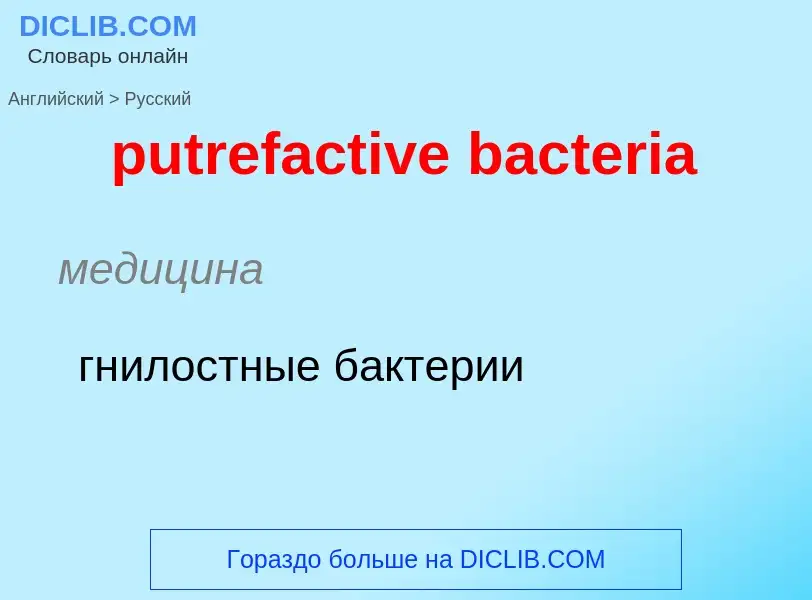Translation and analysis of words by ChatGPT artificial intelligence
On this page you can get a detailed analysis of a word or phrase, produced by the best artificial intelligence technology to date:
- how the word is used
- frequency of use
- it is used more often in oral or written speech
- word translation options
- usage examples (several phrases with translation)
- etymology
putrefactive bacteria - translation to russian
медицина
гнилостные бактерии
общая лексика
шизомицеты
[bæk'ti(ə)riəl]
общая лексика
бактериальный
медицина
бактерийный
прилагательное
общая лексика
бактериальный
Wikipedia
Iron-oxidizing bacteria (or iron bacteria) are chemotrophic bacteria that derive energy by oxidizing dissolved iron. They are known to grow and proliferate in waters containing iron concentrations as low as 0.1 mg/L. However, at least 0.3 ppm of dissolved oxygen is needed to carry out the oxidation.
When de-oxygenated water reaches a source of oxygen, iron bacteria convert dissolved iron into an insoluble reddish-brown gelatinous slime that discolors stream beds and can stain plumbing fixtures, clothing, or utensils washed with the water carrying it. Organic material dissolved in water is often the underlying cause of an iron-oxidizing bacteria population. Groundwater may be naturally de-oxygenated by decaying vegetation in swamps. Useful mineral deposits of bog iron ore have formed where groundwater has historically emerged and been exposed to atmospheric oxygen. Anthropogenic hazards like landfill leachate, septic drain fields, or leakage of light petroleum fuels like gasoline are other possible sources of organic materials allowing soil microbes to de-oxygenate groundwater. A similar reaction may form black deposits of manganese dioxide from dissolved manganese but is less common because of the relative abundance of iron (5.4%) in comparison to manganese (0.1%) in average soils. The sulfurous smell of rot or decay sometimes associated with iron-oxidizing bacteria results from the enzymatic conversion of soil sulfates to volatile hydrogen sulfide as an alternative source of oxygen in anaerobic water.
Iron is a very important chemical element required by living organisms to carry out numerous metabolic reactions such as the formation of proteins involved in biochemical reactions. Examples of these proteins include iron–sulfur proteins, hemoglobin, and coordination complexes. Iron has a widespread distribution globally and is considered one of the most abundant elements in the Earth's crust, soil, and sediments. Iron is a trace element in marine environments. Its role in the metabolism of some chemolithotrophs is probably very ancient.
As Liebig's law of the minimum notes, the essential element present in the smallest amount (called limiting factor) is the one that determines the growth rate of a population. Iron is the most common limiting element in phytoplankton communities and has a key role in structuring and determining their abundance. It is particularly important in the high-nutrient, low-chlorophyll regions, where the presence of micronutrients is mandatory for the total primary production.



![[[Antonie van Leeuwenhoek]], the first [[microbiologist]] and the first person to observe bacteria using a [[microscope]]. [[Antonie van Leeuwenhoek]], the first [[microbiologist]] and the first person to observe bacteria using a [[microscope]].](https://commons.wikimedia.org/wiki/Special:FilePath/Anthonie van Leeuwenhoek (1632-1723). Natuurkundige te Delft Rijksmuseum SK-A-957.jpeg?width=200)
![Rod-shaped ''[[Bacillus subtilis]]'' Rod-shaped ''[[Bacillus subtilis]]''](https://commons.wikimedia.org/wiki/Special:FilePath/Bacillus subtilis 2.jpg?width=200)

![electron micrograph]] of ''[[Halothiobacillus neapolitanus]]'' cells with [[carboxysome]]s inside, with arrows highlighting visible carboxysomes. Scale bars indicate 100 nm. electron micrograph]] of ''[[Halothiobacillus neapolitanus]]'' cells with [[carboxysome]]s inside, with arrows highlighting visible carboxysomes. Scale bars indicate 100 nm.](https://commons.wikimedia.org/wiki/Special:FilePath/Carboxysomes EM ptA.jpg?width=200)

![''[[Helicobacter pylori]]'' electron micrograph, showing multiple flagella on the cell surface ''[[Helicobacter pylori]]'' electron micrograph, showing multiple flagella on the cell surface](https://commons.wikimedia.org/wiki/Special:FilePath/EMpylori.jpg?width=200)



![''[[Neisseria gonorrhoeae]]'' and pus cells from a penile discharge ([[Gram stain]]) ''[[Neisseria gonorrhoeae]]'' and pus cells from a penile discharge ([[Gram stain]])](https://commons.wikimedia.org/wiki/Special:FilePath/Neisseria gonorrhoeae and pus cells.jpg?width=200)
![In [[bacterial vaginosis]], beneficial bacteria in the vagina (top) are displaced by pathogens (bottom). Gram stain. In [[bacterial vaginosis]], beneficial bacteria in the vagina (top) are displaced by pathogens (bottom). Gram stain.](https://commons.wikimedia.org/wiki/Special:FilePath/Normal and BV flora.jpg?width=200)
![Colour-enhanced scanning electron micrograph showing ''[[Salmonella typhimurium]]'' (red) invading cultured human cells Colour-enhanced scanning electron micrograph showing ''[[Salmonella typhimurium]]'' (red) invading cultured human cells](https://commons.wikimedia.org/wiki/Special:FilePath/SalmonellaNIAID.jpg?width=200)

